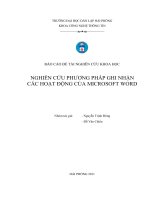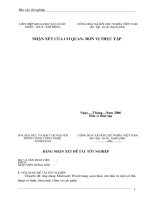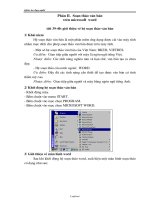Microsoft word document40
Bạn đang xem bản rút gọn của tài liệu. Xem và tải ngay bản đầy đủ của tài liệu tại đây (501.43 KB, 4 trang )
The percentage of housing was 21%. (X)
• The proportion of money which was spent on
housing was 21%.
• Housing accounted for approximately 21% in
total budget of Japanese.
Note
• Account for = make up = take up: chiếm.
• To be responsible for = occupy = constitute.
The given pie charts clearly detail how much money was
allocated for various sectors by Japanese and Malaysian in
2010.
Overall, it is patently obvious that housing and food were
recognized as the primary sectors that were spent the largest
portion of budget in both nations. Also, Japanese tended to
spend more money on transport and health care than
Malaysian.
Looking back in more detail, there was approximately one-fifth
of total income was allocated for accommodation in Japan,
which was much lower than that of Malaysia with over a third.
When it comes to food, the Japanese spent roughly a quarter
of their budget on this sector. This figure was relatively similar
as compared with Malaysia (27%).
Turning to the remaining categories, the proportions of money
spent on transport and healthcare by people in Japan were
nearly double that in Malaysia, with their figures occupying
20%, 6% and 10%, 3% respectively. Regarding other goods and
services, which is not specified in the charts, both Japanese and
Malaysian allocated the relatively similar fraction of budget for
this category with roughly a quarter for each.
The bar chart gives information about the proportion of
teachers by genders in six types of educational institutions
in the UK in 2010.
Overall, the higher the level of education, the higher the
figure for male teachers, and the opposite was true for that
of females. Additionally, the biggest disparity in gender of
teachers was clearly witnessed in pre-school education
level.
The proportion of females working in pre-school was by far
highest at over 90%.
The majority of female teachers chose to work in preschool with approximately 90%.
Women dominated the teaching profession in pre-school
education, with over 90%, whereas the percentage of males
was just around 5%. The same pattern can be seen in
primary schools, with the figure for females being far
higher than that of their counterparts, with 90% and 10%
respectively. The gap between two genders was much
narrower in secondary schools, with 55% for females and
45% for males.
It is noticeable that the proportions of male and female
lectures in colleges were relatively similar, at approximately
50%, whereas the figures for male teachers in private
training institutes was more significant than that of
females, with nearly 60% and over 40% respectively.
University recorded the highest percentage of male
instructors, at about 70%, over two times as much as the
figure for females with less than a third.









